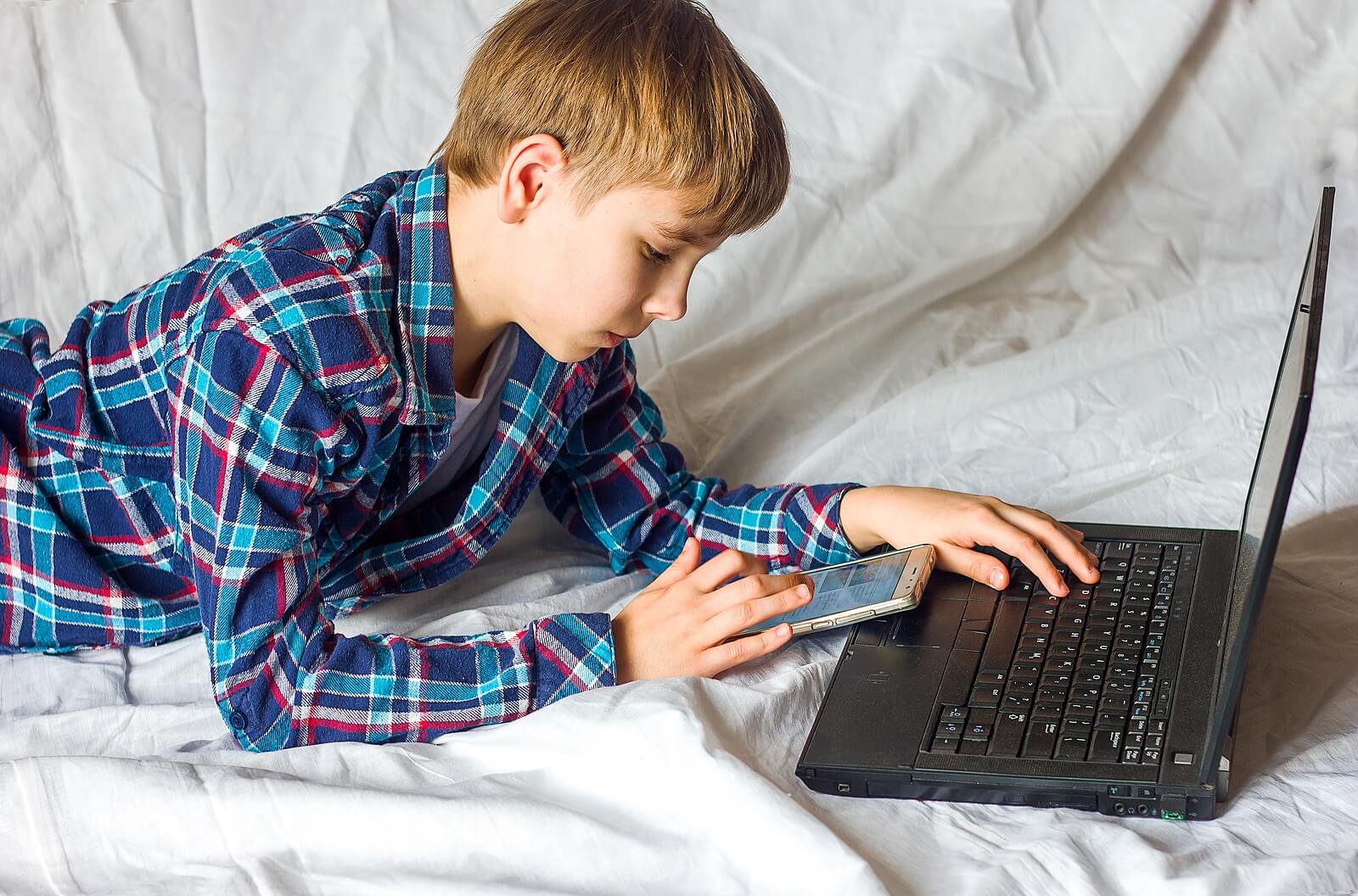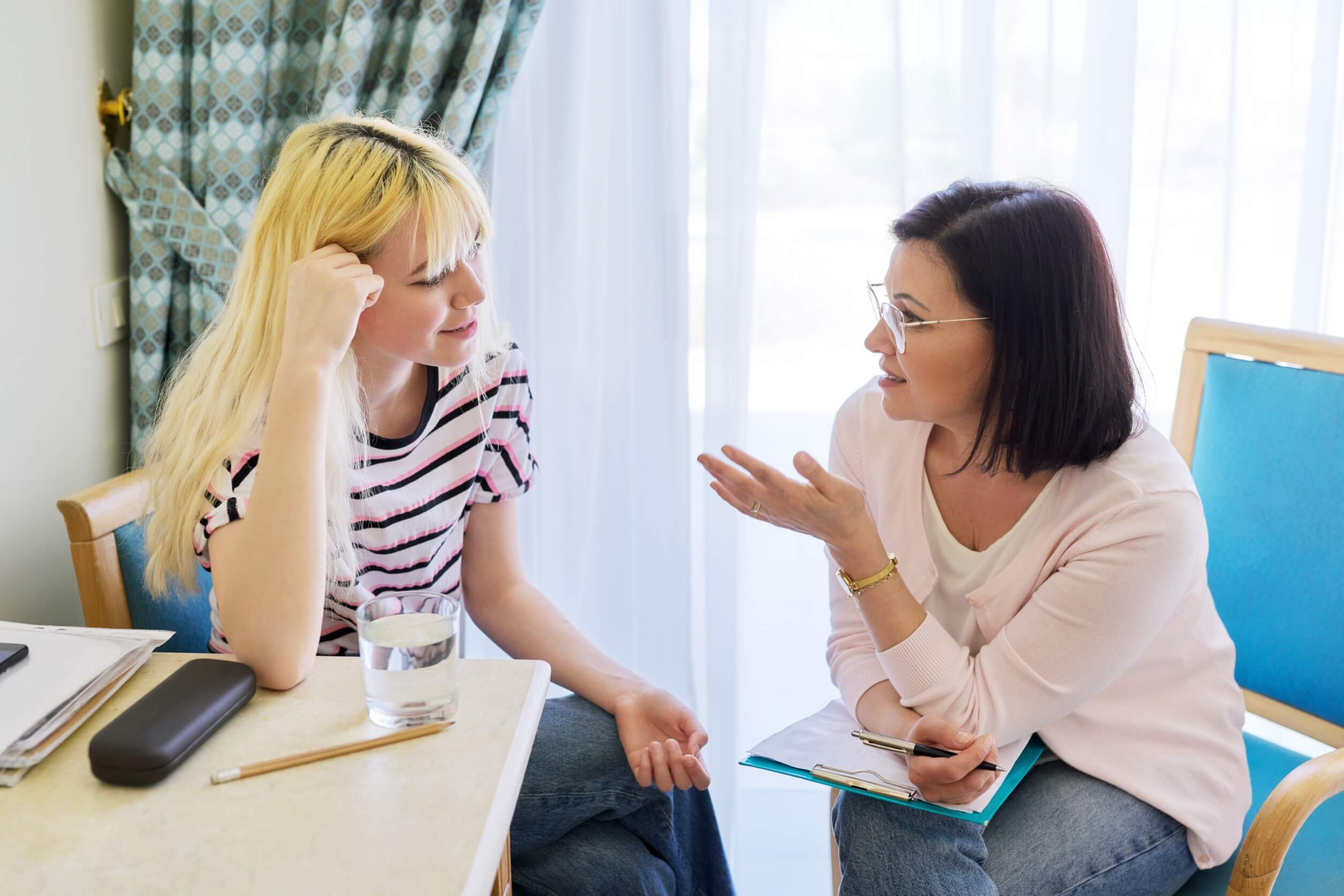Increased Anxiety in Adolescents


Written and verified by the psychologist Maria Fátima Seppi Vinuales
Anxiety may be a typical or expected response to the complexity of adolescence. However, different research shows an increase in anxiety in adolescents in recent times.
The influence of social networks, peer group pressure, and excessive adult expectations are among the causes that explain its growth. Let’s look at their symptoms to recognize the warning signs and how we adults can accompany them.
Anxiety in adolescents
First of all, anxiety is an adaptive response, whose emotional basis is fear, which allows us to activate defenses or escape mechanisms in the face of a situation that we perceive as alarming.
However, when it becomes a habitual response to everything that happens to us, it’s dysfunctional because it prevents us from evaluating a situation correctly and we live in a state of alarm.
Anxiety is present in adolescence due to the characteristics and challenges of this stage of life. For example, the construction of identity, the search for autonomy, and peer acceptance are of great relevance and can generate emotional ups and downs.
In addition, individually it depends on certain genetic predispositions and vulnerability to stress and anxiety. Even in adolescence, some disorders or problems appear for the first time and then persist into adulthood.
Why has anxiety in adolescents increased?

If we wonder about the reason for the increase in anxiety in adolescents, it’s important to take into account multiple variables.
One of them has to do with the aspects of modern times, which include the influence and exposure of social networks. Getting a like and having multiple followers generates both expectation and dependence.
It’s the famous “what will people say?”, but boosted to much larger and unmanageable scales. Therefore, self-esteem, acceptance, and evaluation are under constant scrutiny.
Also, the current dizzying pace, which leads teenagers to have a full schedule of activities, the pressure to stand out and be successful. From school to sports class, then language, then school obligations. This leaves little time for rest and leisure. Everything demands a response and the demand is now.
Finally, the increase in anxiety in adolescents must also be looked at from the post-pandemic perspective. Since 2020 and until a few months ago, this climate of uncertainty, alarming figures, and restrictions still prevailed.
The abrupt interruption of routines -with its consequent influence on sleep and food-, the suddenness of isolation, the loss of family members, the socioeconomic impact on each household, etc. These are just some of the ravages of the pandemic, with effects on an adolescent psyche still under construction.
We’re living in a time when the consequences on the mental health of young people are visible in anxiety and its multiple manifestations: Generalized anxiety, social phobia, and panic disorders, to mention a few.
The symptoms of anxiety in adolescence
Anxiety is adaptive at a tolerable level. When it becomes chronic and pervasive, it becomes unpleasant and affects daily life. Some of the symptoms of anxiety in adolescence that we should pay attention to are the following:
- Nervousness, hyperactivity
- Fear, alertness, and worry
- Frequent mood swings, irritability
- Changes or difficulties in academic performance
- Difficulties with sleep
- Rigid posture due to muscular tension
- Problems with concentration and starting and finishing tasks
- Discomfort or complaints of somatic symptoms: Headache, stomach ache
You may be interested in: 3 Tips to Manage Digital Stress in Children and Teenagers
How to accompany a teenager with anxiety?
There are different aspects to take into account when accompanying a teenager with anxiety.
Validate what they feel
If we consider that teenagers seek acceptance, not knowing what they feel is equivalent to closing off access to what’s happening to them. Therefore, if we notice that they’re having a hard time, the first thing to do is empathize with the situation.
Avoid phrases such as “you’ll get over it” or “it’s not that bad”. Even when they’re said with good intentions, we can make them feel that we’re minimizing the situation.
Create spaces for dialogue
Sometimes, we get the idea that teenagers are locked up in their own world and don’t want us around. However, it’s good to ask ourselves about the way we approach them.
How and what do we ask? How do we answer them when they talk to us? Do we talk to them as “preachy adults” or do we try to “go back to being teenagers”, trying to understand what they feel and to offer an appropriate response?
It’s also a good idea to try to create a more intimate atmosphere where they’re relaxed and choose places where they feel at ease. Talking at dinner, in front of the rest of the family, isn’t the same as doing it in their room. A good way to open dialogue is to share how your day was and how you feel, and show yourself as authentic.
Show respect and understanding
What seems “super easy” to us adults to solve may be an obstacle course for them. Therefore, it’s important to respect their time, accompany their processes, and understand the steps.
Ask for professional help

Although we can be of help, not everything is in our hands. There are some situations of greater complexity that require the intervention of suitable professionals.
For example, eating disorders, with symptoms such as bulimia and anorexia, may reveal the pressure regarding body image, the difficulty of coping with stress, and a host of situations that must be addressed comprehensively. In this regard, when in doubt, it’s always best to consult with experts on the subject and not minimize the situation.
You may be interested in: How Journaling Helps Teenagers Emotionally
Thinking about ourselves
Both in the case of children and adolescents, when we detect that something’s happening to them, we must also reflect on ourselves.
Sometimes, we can be too rigid or demanding about their activities, the expectations we place on them, the pressure we transmit, etc. Reflecting on these things allows us to adjust and “readjust” our parenting guidelines to the particular child and circumstances.
At the same time, and perhaps in relation to other issues, we often think “I didn’t see this coming”. The goal isn’t to seek blame or make judgments, but to think about what we may have overlooked and how we can act from now on.
Sometimes, we fall into the delusion that they no longer need us and that they’re self-sufficient. Other times, it’s our own work pace that prevents us from keeping up with what’s going on at home. Whatever the cause, perhaps it’s also a matter of “rescuing” our role as role models and accompanying adults.
Anxiety may be a typical or expected response to the complexity of adolescence. However, different research shows an increase in anxiety in adolescents in recent times.
The influence of social networks, peer group pressure, and excessive adult expectations are among the causes that explain its growth. Let’s look at their symptoms to recognize the warning signs and how we adults can accompany them.
Anxiety in adolescents
First of all, anxiety is an adaptive response, whose emotional basis is fear, which allows us to activate defenses or escape mechanisms in the face of a situation that we perceive as alarming.
However, when it becomes a habitual response to everything that happens to us, it’s dysfunctional because it prevents us from evaluating a situation correctly and we live in a state of alarm.
Anxiety is present in adolescence due to the characteristics and challenges of this stage of life. For example, the construction of identity, the search for autonomy, and peer acceptance are of great relevance and can generate emotional ups and downs.
In addition, individually it depends on certain genetic predispositions and vulnerability to stress and anxiety. Even in adolescence, some disorders or problems appear for the first time and then persist into adulthood.
Why has anxiety in adolescents increased?

If we wonder about the reason for the increase in anxiety in adolescents, it’s important to take into account multiple variables.
One of them has to do with the aspects of modern times, which include the influence and exposure of social networks. Getting a like and having multiple followers generates both expectation and dependence.
It’s the famous “what will people say?”, but boosted to much larger and unmanageable scales. Therefore, self-esteem, acceptance, and evaluation are under constant scrutiny.
Also, the current dizzying pace, which leads teenagers to have a full schedule of activities, the pressure to stand out and be successful. From school to sports class, then language, then school obligations. This leaves little time for rest and leisure. Everything demands a response and the demand is now.
Finally, the increase in anxiety in adolescents must also be looked at from the post-pandemic perspective. Since 2020 and until a few months ago, this climate of uncertainty, alarming figures, and restrictions still prevailed.
The abrupt interruption of routines -with its consequent influence on sleep and food-, the suddenness of isolation, the loss of family members, the socioeconomic impact on each household, etc. These are just some of the ravages of the pandemic, with effects on an adolescent psyche still under construction.
We’re living in a time when the consequences on the mental health of young people are visible in anxiety and its multiple manifestations: Generalized anxiety, social phobia, and panic disorders, to mention a few.
The symptoms of anxiety in adolescence
Anxiety is adaptive at a tolerable level. When it becomes chronic and pervasive, it becomes unpleasant and affects daily life. Some of the symptoms of anxiety in adolescence that we should pay attention to are the following:
- Nervousness, hyperactivity
- Fear, alertness, and worry
- Frequent mood swings, irritability
- Changes or difficulties in academic performance
- Difficulties with sleep
- Rigid posture due to muscular tension
- Problems with concentration and starting and finishing tasks
- Discomfort or complaints of somatic symptoms: Headache, stomach ache
You may be interested in: 3 Tips to Manage Digital Stress in Children and Teenagers
How to accompany a teenager with anxiety?
There are different aspects to take into account when accompanying a teenager with anxiety.
Validate what they feel
If we consider that teenagers seek acceptance, not knowing what they feel is equivalent to closing off access to what’s happening to them. Therefore, if we notice that they’re having a hard time, the first thing to do is empathize with the situation.
Avoid phrases such as “you’ll get over it” or “it’s not that bad”. Even when they’re said with good intentions, we can make them feel that we’re minimizing the situation.
Create spaces for dialogue
Sometimes, we get the idea that teenagers are locked up in their own world and don’t want us around. However, it’s good to ask ourselves about the way we approach them.
How and what do we ask? How do we answer them when they talk to us? Do we talk to them as “preachy adults” or do we try to “go back to being teenagers”, trying to understand what they feel and to offer an appropriate response?
It’s also a good idea to try to create a more intimate atmosphere where they’re relaxed and choose places where they feel at ease. Talking at dinner, in front of the rest of the family, isn’t the same as doing it in their room. A good way to open dialogue is to share how your day was and how you feel, and show yourself as authentic.
Show respect and understanding
What seems “super easy” to us adults to solve may be an obstacle course for them. Therefore, it’s important to respect their time, accompany their processes, and understand the steps.
Ask for professional help

Although we can be of help, not everything is in our hands. There are some situations of greater complexity that require the intervention of suitable professionals.
For example, eating disorders, with symptoms such as bulimia and anorexia, may reveal the pressure regarding body image, the difficulty of coping with stress, and a host of situations that must be addressed comprehensively. In this regard, when in doubt, it’s always best to consult with experts on the subject and not minimize the situation.
You may be interested in: How Journaling Helps Teenagers Emotionally
Thinking about ourselves
Both in the case of children and adolescents, when we detect that something’s happening to them, we must also reflect on ourselves.
Sometimes, we can be too rigid or demanding about their activities, the expectations we place on them, the pressure we transmit, etc. Reflecting on these things allows us to adjust and “readjust” our parenting guidelines to the particular child and circumstances.
At the same time, and perhaps in relation to other issues, we often think “I didn’t see this coming”. The goal isn’t to seek blame or make judgments, but to think about what we may have overlooked and how we can act from now on.
Sometimes, we fall into the delusion that they no longer need us and that they’re self-sufficient. Other times, it’s our own work pace that prevents us from keeping up with what’s going on at home. Whatever the cause, perhaps it’s also a matter of “rescuing” our role as role models and accompanying adults.
All cited sources were thoroughly reviewed by our team to ensure their quality, reliability, currency, and validity. The bibliography of this article was considered reliable and of academic or scientific accuracy.
- Cárdenas EM, Feria M, Palacios L, De la Peña F. Guía Clínica para los trastornos de ansiedad en niños y adolescentes. Instituto Nacional de Psiquiatría Ramón de la Fuente Muñiz, México 2010.
- Sánchez Boris, Isabel María. (2021). Impacto psicológico de la COVID-19 en niños y adolescentes. MEDISAN, 25(1), 123-141. Epub 15 de febrero de 2021. Recuperado en 18 de octubre de 2022, de http://scielo.sld.cu/scielo.php?script=sci_arttext&pid=S1029-30192021000100123&lng=es&tlng=es.
- Díaz Santos C, Santos Vallín L. La ansiedad en la adolescencia. RqR Enfermería Comunitaria (Revista de
SEAPA). 2018 Febrero; 6(1): 21-31. - Zúñiga Rodríguez, Maricela (2014). EL TRASTORNO DE ANSIEDAD Y ESTRÉS ESCOLAR EN LOS ADOLESCENTES CON ALTO DESEMPEÑO ACADÉMICO. International Journal of Developmental and Educational Psychology, 2(1),205-212.[fecha de Consulta 19 de Octubre de 2022]. ISSN: 0214-9877. Disponible en: https://www.redalyc.org/articulo.oa?id=349851782020.
- World Health Organization. (2022). Mental health and COVID-19: early evidence of the pandemic’s impact: scientific brief, 2 March 2022. World Health Organization. https://apps.who.int/iris/handle/10665/352189. Licencia: CC BY-NC-SA 3.0 IGO.
This text is provided for informational purposes only and does not replace consultation with a professional. If in doubt, consult your specialist.








